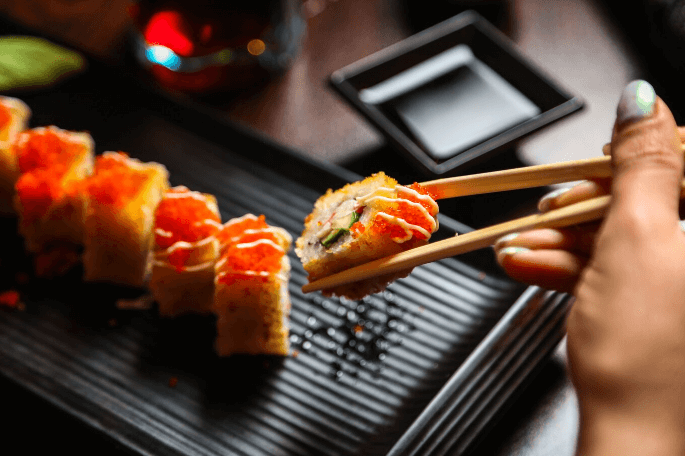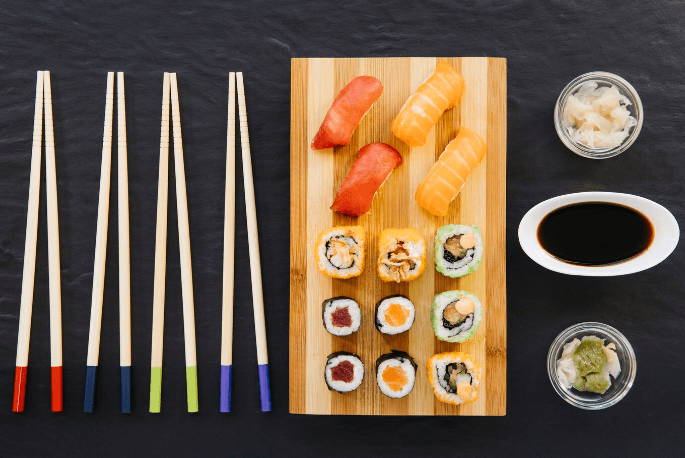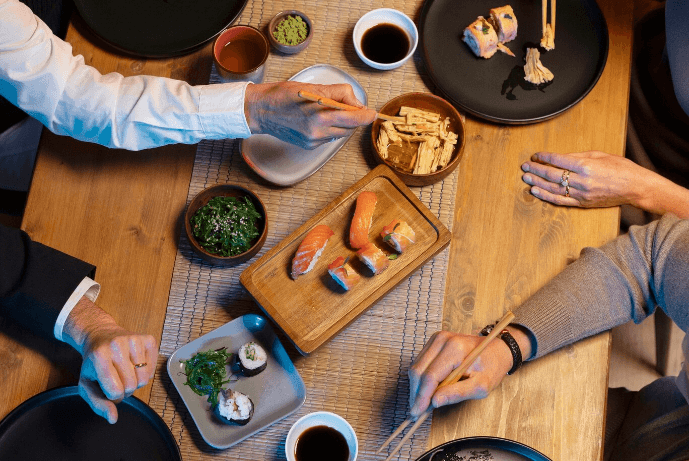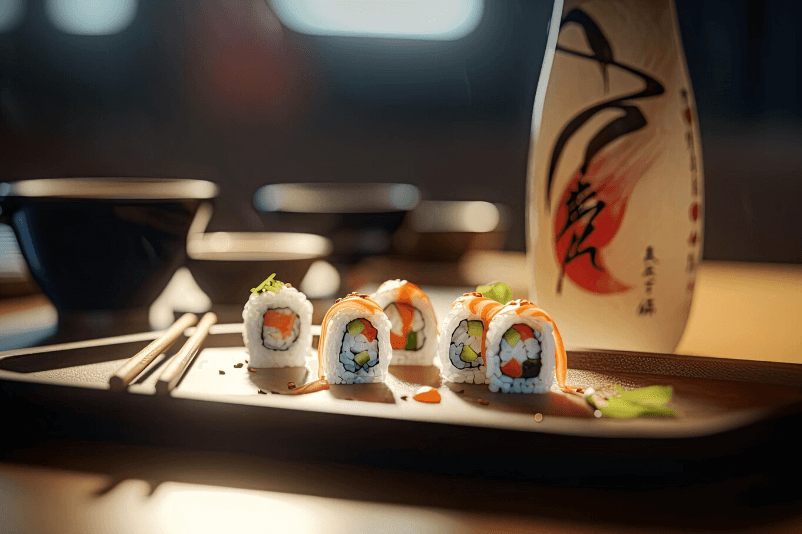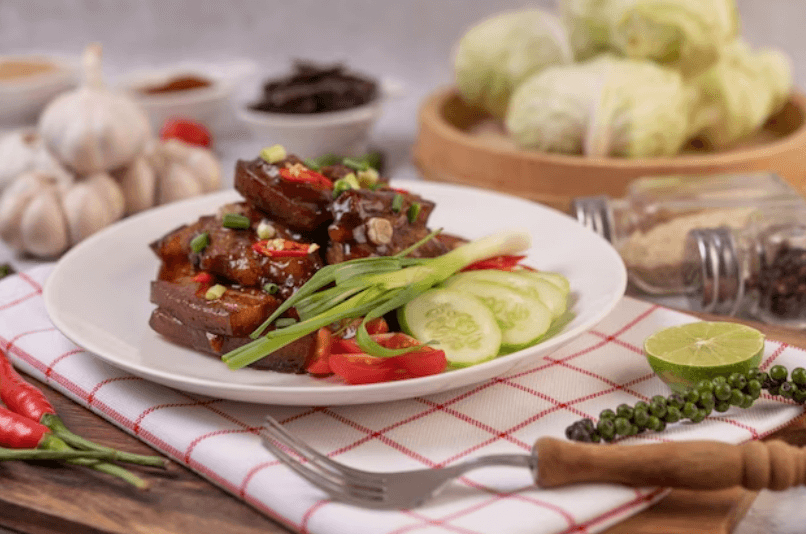What Is Smelt, Roe Sushi, Smelt egg And Why Would You Want It?
Eating raw fish can often be an acquired taste, but most people find they enjoy it after they get used to the flavor. If you want to try something new, or if you’re looking for a break from the standard sushi options, consider smelt roe sushi. This little-known, yet popular dish offers a unique taste that’s sure to impress your palate!
Introduction to smelt roe sushi
When it comes to sushi, there are endless possibilities. You can have your sushi with fish, vegetables, or even fruit. And then there’s the matter of what kind of fish you want. Do you want tuna? Salmon? Yellowtail?
But have you ever considered smelt roe sushi? It’s not as common as other types of sushi, but it’s definitely worth trying. Here’s everything you need to know about smelt roe sushi.

What Is Smelt Roe Sushi?
Smelt roe sushi is, simply put, sushi that is made with smelt roe. Smelt roe is the eggs of a smelt fish. These eggs are orange or red in color and have a slightly salty taste. They’re often used as a garnish on other types of sushi (such as salmon roe), but they can also be the star of the show.
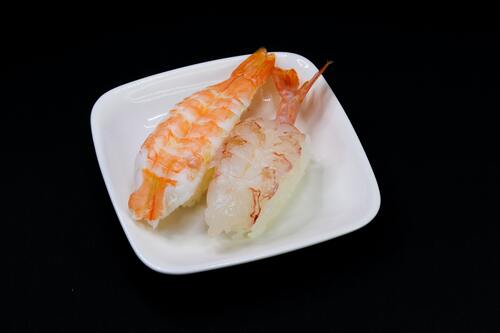
Why Would You Want It?
If you’re looking for something a little different when it comes to your sushi, then smelt roe is a great option. It has a unique flavor that will definitely stand out among other types of sushi. Plus, it’s fun to say! “Smelt roe” just has a certain ring to it, don’t you think?
What is a smelt roe?
Smelt roe, also known as masago, is the tiny eggs of a smelt fish. These bright orange eggs are often used in sushi and are prized for their sweetness and brininess. Masago has a slightly chewy texture and a mild fish flavor that is not as strong as salmon roe or tobiko.
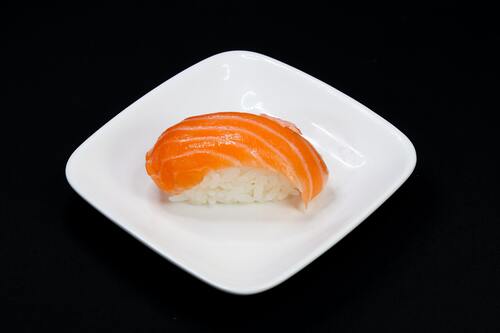
How do you eat it?
If you want to try smelt roe sushi, there are a few ways to eat it. One way is to simply put the sushi in your mouth and bite down. This will release the flavor of the fish and the roe together. Another way to eat it is to chew on the sushi a bit before swallowing. This allows you to taste the individual flavors of the fish and the roe separately. Finally, you can also use your chopsticks to mix the two together before eating. Whichever way you choose, enjoy!
Who eats it?
Smelt roe sushi is a popular dish in many parts of the world, especially in Japan. It is made with smelt eggs, which are small, round, and orange-colored. The eggs are usually marinated in soy sauce and vinegar, and then wrapped in seaweed (nori) and rice.
Smelt roe sushi is often eaten as an appetizer or side dish. It is also a popular party food, as it is easy to make and can be served on small plates or bowls.

What are the benefits of eating this dish?
There are many benefits to eating smelt roe sushi. For one, it is a very healthy dish. It is low in calories and fat, and high in protein and omega-3 fatty acids. It is also a good source of vitamins and minerals, including calcium, phosphorus, and iron.
Another benefit of eating smelt roe sushi is that it is very delicious. The slightly sweet taste of the roe pairs well with the rice and nori (seaweed) in sushi rolls. It also has a unique texture that adds interest to the dish.
Finally, eating smelt roe sushi can be a fun and different experience. If you are tired of the same old sushi flavors, this may be a great option for you to try something new.
What is Smelt Egg Sushi: A Culinary Overview
Smelt Egg Sushi, also known as Masago, is a popular delicacy in Japanese cuisine. It is a type of sushi ingredient that consists of tiny, orange-red fish eggs. These eggs come from the smelt, a small fish that is found in the ocean and rivers of Japan.
The smelt eggs are harvested and carefully processed to create a flavorful and visually appealing sushi topping. The eggs have a slightly crunchy texture and a rich, briny taste that is often described as both sweet and savory. The vibrant orange color of the smelt eggs adds a pop of color to any sushi dish, making it visually appealing as well.
Smelt Egg Sushi is commonly used in various sushi rolls, such as nigiri, maki, and temaki. It is also used as a topping for chirashi sushi and can be served as a garnish for other seafood dishes. The small size of the eggs makes them easy to sprinkle or spread on top of sushi rice or other ingredients.
In addition to its taste and visual appeal, smelt egg sushi also offers several health benefits. It is a good source of protein, omega-3 fatty acids, and various vitamins and minerals. The eggs are also low in calories and fat, making them a healthy choice for sushi lovers.
When enjoying smelt egg sushi, it is important to note that the eggs are perishable and should be consumed fresh. They are typically stored in refrigerated conditions to maintain their freshness and quality. Smelt Egg Sushi can be enjoyed on its own or paired with other sushi ingredients for a flavorful and satisfying meal.
Overall, Smelt Egg Sushi is a unique and delicious addition to Japanese cuisine. Its vibrant color, crunchy texture, and rich flavor make it a popular choice among sushi enthusiasts. Whether enjoyed as a standalone dish or as a topping, smelt egg sushi adds a burst of flavor and visual appeal to any sushi experience.
The Role of Smelt Eggs in Traditional Japanese Sushi
Smelt eggs, also known as “masago” or “capelin roe,” play a crucial role in traditional Japanese sushi. These tiny, orange fish eggs are not only visually appealing but also add a distinct burst of flavor and texture to sushi rolls.
One of the most popular uses of smelt eggs in Japanese cuisine is in the preparation of sushi rolls. They are often used as a topping or filling, adding a vibrant pop of color and a delicate crunch to the dish. The combination of their small size and light texture makes them a perfect complement to the other ingredients in sushi.
The smelt eggs are carefully harvested from the capelin fish, a small fish found in the cold waters of the northern Atlantic and Pacific oceans. The eggs are then washed, salted, and cured to enhance their flavor and preserve their freshness. These meticulous steps ensure that the smelt eggs maintain their unique taste and quality.
When used in sushi, smelt eggs provide a burst of umami flavor that elevates the overall taste profile of the dish. The eggs have a slightly salty and sweet flavor, which pairs well with the fresh seafood and rice in sushi. Their delicate texture adds a pleasant pop and a mildly crisp bite, creating a delightful contrast with the softness of the rice.
Not only do smelt eggs enhance the taste and texture of sushi, but they also contribute to its visual appeal. The bright orange color of the eggs adds a vibrant touch to the sushi roll, making it visually enticing and appetizing. Smelt eggs are often used as a decorative topping, sprinkled over the sushi or formed into a bed, creating an attractive presentation.
Smelt eggs are a staple in traditional Japanese sushi and are loved for their unique flavor, texture, and visual appeal. Whether used as a topping, filling, or decorative element, these tiny fish eggs bring a touch of elegance and sophistication to any sushi dish.
Experience the exquisite taste of smelt eggs in our authentic Japanese sushi today!
Understanding Smelt Eggs and Roe
Smelt eggs, also known as roe, are a delicacy in Japanese cuisine. They are tiny, orange-colored eggs that come from the smelt fish species. Smelt eggs are highly prized for their rich, briny flavor and are a popular ingredient in sushi, sashimi, and other traditional Japanese dishes.
Smelt eggs are harvested by carefully extracting them from the smelt fish. The eggs are then carefully rinsed and processed to remove any impurities, ensuring that only the highest quality eggs make it to your plate.
These tiny eggs burst with flavor and have a unique texture. They have a slightly crunchy exterior, which gives way to a creamy, velvety interior. The flavor is often described as both salty and slightly sweet, with a hint of the sea.
Smelt eggs are not only delicious but also incredibly nutritious. They are rich in omega-3 fatty acids, which are essential for brain health and can help lower cholesterol levels. Additionally, they contain high levels of vitamins and minerals, such as vitamin A, calcium, and iron.
When it comes to serving smelt eggs, there are many options. They are commonly used as a topping for sushi rolls or nigiri, adding a burst of flavor and color. Smelt eggs can also be used in salads, garnishes, and even as a topping for pasta dishes.
Next time you’re looking to explore the world of Japanese cuisine, don’t forget to try smelt eggs. Their unique flavor and texture make them a must-try delicacy. Whether you’re a sushi aficionado or simply curious about new flavors, smelt eggs are sure to impress. Enjoy!
Defining Smelt Eggs and Roe: What Are They?
When it comes to Japanese cuisine, one of the delicacies that stands out is smelt eggs, also known as roe. Smelt eggs are tiny, vibrant orange pearls that burst with flavor when eaten. They are commonly used as a topping or filling for sushi, adding a unique texture and taste to each bite.
Roe, on the other hand, is a term that refers to the eggs of various fish species. Smelt eggs are just one type of roe found in Japanese cuisine, but they are particularly popular due to their distinctive flavor and appearance.
Smelt eggs are harvested from the smelt fish, which is a small, silvery fish found in the cold waters of the Northern Hemisphere. The eggs are carefully extracted and processed to ensure their quality and taste. They are often lightly salted to enhance their natural flavor and preserved for longer shelf life.
What sets smelt eggs apart from other types of roe is their unique texture and flavor profile. These tiny eggs burst with a slightly salty and briny taste, complemented by a buttery and creamy texture. When combined with the freshness of sushi rice and other ingredients, smelt eggs create a delightful flavor sensation that is often savored by sushi enthusiasts.
Smelt eggs are not only prized for their taste but also for their nutritional value. They are packed with essential nutrients such as omega-3 fatty acids, protein, vitamins, and minerals. These nutrients are known to promote heart health, brain function, and overall well-being.
Whether you are a seafood lover or someone looking to expand your culinary horizons, smelt eggs are a must-try delicacy in Japanese cuisine. Their vibrant color, unique flavor, and nutrient-packed profile make them a standout ingredient in sushi and other dishes. So, why not indulge your taste buds and experience the joy of exploring smelt egg sushi?
The Taste Profile of Smelt Roe: Flavor and Texture Explained
Smelt roe, also known as masago, is a small delicacy that is widely used in Japanese cuisine. It is often used as a garnish, topping, or ingredient in various dishes. This article will explore the flavor and texture of smelt roe, giving you a deeper understanding of its taste profile.
When it comes to flavor, smelt roe has a unique and distinctive taste. It is briny and salty, with a hint of sweetness. The brininess is reminiscent of the sea, adding a refreshing and vibrant taste to the palate. The saltiness provides a savory element, enhancing the overall flavor of the dish. The slight sweetness balances out the salty and briny notes, creating a harmonious flavor profile.
In terms of texture, smelt roe has a small size and a slightly crunchy texture. The individual roe beads pop in your mouth, releasing a burst of flavor. The crunchiness adds a pleasant texture contrast to other ingredients in the dish. It can be likened to miniature fish eggs, providing a unique texture experience.
Smelt roe is often used as a topping for sushi, where its flavor and texture complement the other ingredients. It can also be used in salads, rice bowls, and as a garnish for various seafood dishes. Its vibrant color and distinct taste make it a popular choice in Japanese cuisine.
- Briny and salty flavor with a hint of sweetness
- Refreshing and vibrant taste
- Small, crunchy texture with roe beads that pop in the mouth
- Unique addition to sushi, salads, rice bowls, and seafood dishes
In conclusion, smelt roe is a delicacy in Japanese cuisine that offers a unique flavor and texture experience. Its briny and salty flavor, along with a hint of sweetness, provides a refreshing and vibrant taste. The small and crunchy texture, with roe beads that pop in the mouth, adds a pleasant texture contrast to dishes. Whether used as a topping or garnish, smelt roe is a versatile ingredient that enhances the overall taste profile of various dishes.
Smelt Roe vs. Salmon Roe: Comparing Sushi Ingredients
When it comes to sushi, the choice of ingredients can make all the difference in terms of taste and culinary experience. Two popular choices for sushi toppings are smelt roe and salmon roe. While both types of roe add a burst of flavor and texture to sushi, there are some key differences between them that are worth exploring.
Smelt roe, also known as masago, is the roe of the small fish called smelt. It is often bright orange in color and has a crunchy texture. Smelt roe has a subtle and delicate flavor, making it a popular choice for sushi rolls and nigiri. It is often used in traditional Japanese cuisine and is loved for its mild taste that doesn’t overpower the other flavors in the dish.
On the other hand, salmon roe, also known as ikura, is the roe of the salmon fish. It is larger in size compared to smelt roe and has a distinct vibrant orange or red color. Salmon roe has a rich and buttery flavor, with a slightly salty taste. It pops in your mouth, releasing a burst of savory goodness that adds a unique element to sushi. Its bold flavor makes it a favorite among sushi enthusiasts who crave a stronger taste experience.
Both smelt roe and salmon roe have their own unique characteristics that contribute to the overall taste and enjoyment of sushi. The choice between them ultimately comes down to personal preference. If you prefer a more delicate and subtle flavor, smelt roe is a great option. On the other hand, if you enjoy a stronger and more intense flavor profile, salmon roe is the way to go. Whichever you choose, both types of roe are sure to elevate your sushi experience to new heights.
| Smelt Roe | Salmon Roe |
|---|---|
| Small and crunchy | Large and pops in your mouth |
| Subtle and delicate flavor | Rich and buttery flavor |
| Bright orange color | Vibrant orange or red color |
| Doesn’t overpower other flavors | Adds a unique, intense taste |
Preparation and Types of Smelt Egg Sushi
Smelt egg sushi, also known as masago sushi, is a delicacy in Japanese cuisine that is loved for its unique taste and texture. The preparation of smelt egg sushi involves a delicate process that requires expertise and precision.
Preparation:
The first step in preparing smelt egg sushi is to select fresh and high-quality smelt eggs. These tiny orange pearls are carefully harvested from smelt fish and are known for their burst of flavor. Once the eggs are selected, they are washed and strained to remove any impurities.
Next, the smelt eggs are seasoned with a mixture of soy sauce, mirin (a sweet rice wine), and sake. This seasoning adds a savory and slightly sweet flavor to the eggs. The eggs are then gently mixed to ensure that they are evenly coated in the seasoning.
Types of Smelt Egg Sushi:
Smelt egg sushi can be enjoyed in various forms, each offering a unique taste experience. Here are some popular types of smelt egg sushi:
- Nigiri: Nigiri smelt egg sushi is made by placing a small mound of seasoned smelt eggs on a bed of pressed sushi rice. It is commonly garnished with a thin strip of nori (seaweed) and served with soy sauce and wasabi.
- Gunkan: Gunkan smelt egg sushi is made by wrapping a strip of nori around a mound of seasoned smelt eggs and sushi rice. It is often topped with a slice of fresh seafood, such as salmon or tuna, creating a flavorful combination.
- Maki: Maki smelt egg sushi is made by rolling seasoned smelt eggs and sushi rice in a sheet of nori. This type of sushi is often cut into bite-sized pieces and served with soy sauce and pickled ginger.
- Temaki: Temaki smelt egg sushi, also known as a hand roll, is made by wrapping a cone-shaped nori sheet around a mixture of seasoned smelt eggs and sushi rice. It is a popular choice for on-the-go sushi lovers.
Whether you prefer the simplicity of nigiri or the flavor combinations of gunkan and maki, smelt egg sushi offers a delightful dining experience for sushi enthusiasts.
How Smelt Eggs are Prepared for Sushi
Smelt eggs, also known as “masago” in Japanese cuisine, are a popular ingredient in sushi dishes. These tiny, orange eggs add a burst of flavor and texture to the sushi, making it a favorite choice among sushi enthusiasts.
Preparing smelt eggs for sushi involves several steps to ensure that they are fresh, flavorful, and safe to eat. Here is a step-by-step guide on how smelt eggs are prepared for sushi:
| Step | Description |
|---|---|
| 1 | Harvesting |
| 2 | Removing impurities |
| 3 | Washing |
| 4 | Marinating |
| 5 | Packaging |
Firstly, the smelt eggs are harvested from the fish. The fish are carefully caught and then the eggs are extracted to ensure their freshness. It is important to handle the eggs with care to prevent any damage.
Next, the smelt eggs are carefully inspected and any impurities such as dirt or debris are removed. This step ensures that only clean and high-quality eggs are used for sushi preparation.
After the impurities are removed, the smelt eggs are washed thoroughly to ensure their cleanliness. This step helps to eliminate any remaining impurities and ensures that the eggs are safe to consume.
Once the washing process is complete, the smelt eggs are then marinated to enhance their flavor. They are typically marinated in a combination of soy sauce, mirin, and rice vinegar. This step adds a savory and slightly sweet taste to the eggs, complementing the overall flavor of the sushi.
Finally, the marinated smelt eggs are carefully packaged to maintain their freshness. They are often packed in small containers or bags, ready to be used by sushi chefs in various sushi dishes.
Overall, the process of preparing smelt eggs for sushi involves careful handling, thorough cleaning, and marinating to ensure that they are of the highest quality. The dedication and attention to detail in preparing smelt eggs contribute to the delicious and authentic taste of sushi.
Different Types of Sushi Featuring Smelt Eggs: Nigiri, Rolls, and Sashimi
Smelt eggs, also known as masago, are a popular ingredient in Japanese cuisine, particularly when it comes to sushi. These tiny, orange-colored fish eggs add a burst of flavor and a touch of sophistication to any sushi dish. From nigiri to rolls and sashimi, smelt eggs are used in various types of sushi, each offering a different culinary experience.
Nigiri:
Nigiri sushi is perhaps the most traditional and well-known way to enjoy the delicate taste of smelt eggs. In nigiri sushi, a small mound of vinegared sushi rice is topped with a slice of fresh fish or seafood and garnished with a small amount of smelt eggs. The combination of textures, flavors, and colors creates a harmonious balance that is both visually appealing and incredibly delicious.
Rolls:
When it comes to sushi rolls, smelt eggs can be used as a filling, a topping, or even both. The creamy, briny flavor of the smelt eggs complements the other ingredients in the roll, adding a pop of flavor and texture. Whether it’s a classic California roll with avocado, crab meat, and smelt eggs or a spicy tuna roll with a smelt egg garnish, sushi rolls featuring smelt eggs are sure to impress.
Sashimi:
If you prefer a simpler, more refined sushi experience, sashimi is the way to go. Sashimi is thinly sliced raw fish or seafood, served without rice. When it comes to smelt eggs, they can be served alongside the sashimi as a garnish, adding a burst of flavor and visual appeal to the dish. The combination of the delicate, buttery texture of the sashimi and the briny, popping sensation of the smelt eggs creates a taste sensation that is truly unforgettable.
No matter how you choose to enjoy smelt eggs in your sushi, one thing is for certain: they elevate any sushi dish to a whole new level. Their unique flavor and texture make them a delicacy in Japanese cuisine, and their versatility allows them to be used in a variety of sushi preparations. So the next time you’re craving sushi, don’t forget to try out different types of sushi featuring smelt eggs – nigiri, rolls, and sashimi. Your taste buds will thank you!
Creative Uses of Smelt Eggs in Modern Sushi Varieties
Smelt eggs, also known as masago, are tiny, orange-colored fish eggs that are widely used in Japanese cuisine, especially in sushi. While smelt eggs are traditionally associated with nigiri sushi and rolls, they are now being creatively incorporated into a variety of modern sushi dishes, adding a burst of flavor and texture.
One creative use of smelt eggs is in sushi bowls, also known as chirashi bowls. These bowls consist of a bed of sushi rice topped with an assortment of fresh fish, vegetables, and other toppings. Adding a sprinkle of smelt eggs on top of the bowl not only enhances the visual appeal but also adds a pop of flavor.
Another innovative way to use smelt eggs is in sushi burritos. These burritos are made with a seaweed wrap filled with sushi rice, various fillings, and condiments. Including a layer of smelt eggs in the filling not only provides a crunchy texture but also amplifies the umami taste.
Smelt eggs can also be used in sushi rolls as a substitute for traditional caviar. They add a beautiful orange color and burst of tangy flavor to the roll. Combined with other ingredients like fresh fish, avocado, and cucumber, smelt eggs create a delightful sensory experience.
Furthermore, smelt eggs can be incorporated into sushi appetizers and canapes. They can be used as a topping for bite-sized sushi rolls or incorporated into sushi-stuffed mushrooms or cucumber cups. The tiny eggs not only add an elegant touch but also create a harmonious balance of flavors.
In conclusion, smelt eggs are a versatile ingredient that can be creatively used in various modern sushi varieties. Whether it’s sushi bowls, sushi burritos, rolls, or appetizers, the addition of smelt eggs adds a burst of flavor, texture, and visual appeal, elevating the overall dining experience.
Nutritional and Culinary Aspects
The smelt egg sushi, also known as kazunoko sushi, is not only a delicacy in Japanese cuisine but also offers several nutritional benefits. These tiny orange beads pack a punch of flavor and provide a unique texture that delights the palate.
Nutritional Benefits:
The smelt eggs are rich in essential nutrients such as proteins, omega-3 fatty acids, vitamins, and minerals. They are particularly high in vitamin B12, which is essential for the production of red blood cells and maintaining a healthy nervous system. Smelt eggs also contain vitamin D, which helps in the absorption of calcium and promotes bone health.
The omega-3 fatty acids present in smelt eggs have numerous health benefits. They are known to reduce inflammation in the body, improve heart health, and boost brain function. These fatty acids are also beneficial for pregnant women as they contribute to the development of the baby’s brain and eyes.
Culinary Uses:
Smelt egg sushi is popular in Japan for its culinary versatility. These tiny eggs can be enjoyed in various ways:
- As a topping: Smelt eggs are often used as a topping for sushi rolls, adding a burst of color and flavor. They can be paired with different types of fish, vegetables, or other sushi ingredients to enhance the overall taste.
- In gunkan maki: Gunkan maki is a type of sushi where the rice is wrapped in a strip of seaweed and topped with various ingredients. Smelt eggs can be used as a filling for gunkan maki, creating a visually appealing and delicious dish.
- In chirashi sushi: Chirashi sushi is a bowl of sushi rice topped with a variety of ingredients. Smelt eggs can be sprinkled over the rice, adding a flavorful and vibrant touch to the dish.
- In sushi salads: Smelt eggs can also be used in sushi salads, adding a unique texture and taste. They can be combined with fresh vegetables, seaweed, and a tangy dressing to create a refreshing and nutritious salad.
Overall, smelt egg sushi not only satisfies the taste buds but also provides an array of nutritional benefits. Its versatility in culinary applications makes it a popular choice among sushi enthusiasts and those looking to explore the diverse flavors of Japanese cuisine.
The Nutritional Value of Smelt Eggs in Sushi
Smelt eggs, also known as masago, are a popular ingredient in Japanese cuisine, especially in sushi. Not only do they add a burst of flavor and texture to your favorite sushi rolls, but they also offer several nutritional benefits.
High in Protein: Smelt eggs are an excellent source of protein, making them a great choice for those following a vegetarian or vegan diet. They contain approximately 40 grams of protein per 100 grams, helping to support muscle growth and repair.
Rich in Omega-3 Fatty Acids: Omega-3 fatty acids are essential for maintaining heart health and brain function. Smelt eggs are packed with these healthy fats, which can help reduce inflammation, lower blood pressure, and promote overall cardiovascular well-being.
Good Source of Vitamins and Minerals: Smelt eggs are loaded with vital vitamins and minerals, including vitamin B12, vitamin D, iron, and iodine. Vitamin B12 is essential for red blood cell production and energy metabolism, while vitamin D is crucial for bone health and immune function. Iron helps transport oxygen throughout the body, and iodine supports thyroid function.
Low in Calories: Despite their delicious taste, smelt eggs are relatively low in calories, making them a guilt-free addition to your sushi rolls. They provide a satisfying crunch and flavor without adding excessive calories to your meal.
Antioxidant Powerhouse: Smelt eggs are packed with antioxidants, which can help protect your cells from damage caused by free radicals. These antioxidants may help reduce the risk of chronic diseases, such as cancer and heart disease.
So, next time you enjoy a smelt egg sushi roll, not only will you savor its unique taste and texture, but you’ll also benefit from its nutritional value. Incorporating smelt eggs into your diet can contribute to a well-rounded and nutritious eating plan.
Remember to always enjoy sushi in moderation and choose high-quality ingredients to maximize its health benefits.
The Art of Pairing Smelt Egg Sushi with Other Ingredients
When it comes to Japanese cuisine, the delicate flavors and beautiful presentation are what set it apart. Smelt egg sushi, also known as Masago sushi, is no exception. These tiny orange pearls are bursting with flavor and add an exquisite touch to any sushi dish. However, to truly elevate your sushi experience, it’s important to know how to pair smelt egg sushi with other ingredients.
1. Salmon: The natural sweetness of smelt egg sushi pairs perfectly with the rich and buttery flavor of salmon. Whether it’s thinly sliced sashimi or a delicious sushi roll, this combination is a classic favorite among sushi enthusiasts.
2. Avocado: The creaminess of avocado complements the slight crunch of smelt egg sushi, creating a delightful contrast in texture. This combination works well in sushi rolls or as a topping on nigiri sushi.
3. Cucumber: For a refreshing and light pairing, cucumber is an excellent choice. The fresh crunch of cucumber adds a crisp texture to the smelt egg sushi, making it a perfect ingredient for both rolls and nigiri.
4. Soy Sauce: A drizzle of soy sauce enhances the umami flavor of the smelt egg sushi. Dip each sushi bite into the soy sauce to bring out the delicate taste of the smelt eggs.
5. Wasabi: The spiciness of wasabi adds a kick to the smelt egg sushi, providing a burst of flavor in each bite. Be cautious with the amount of wasabi you use, as its heat can overpower the delicate taste of the smelt eggs.
6. Ginger: Ginger is often served alongside sushi as a palate cleanser, and it pairs well with smelt egg sushi too. Take a small bite of ginger between each sushi bite to refresh your taste buds and enhance the overall dining experience.
By experimenting with different combinations and flavors, you can create a unique and personalized sushi experience. Don’t be afraid to try new ingredients and discover your own favorite pairings with smelt egg sushi. The possibilities are endless, and each bite will be a delightful adventure for your taste buds.
Disclaimer: Always make sure to use fresh and high-quality ingredients when preparing sushi. Follow proper food safety guidelines and seek expert advice if you have any dietary restrictions or allergies.
Innovative Culinary Techniques with Smelt Roe in Sushi
When it comes to sushi, there is no shortage of creativity in the culinary world. Chefs around the globe are constantly experimenting with new flavors and textures to create unique sushi experiences. One ingredient that has been gaining popularity in recent years is smelt roe.
Smelt roe, also known as masago, is the vibrant orange eggs of the smelt fish. It is a delicacy in Japanese cuisine, prized for its subtly sweet and briny flavor. Chefs have discovered innovative ways to incorporate smelt roe into sushi, adding a burst of flavor and color to the traditional rolls.
One popular technique is to sprinkle a generous amount of smelt roe on top of a sushi roll. Not only does this add a beautiful pop of color, but it also enhances the overall umami taste of the dish. The tiny eggs provide a satisfying crunch, contrasting with the soft texture of the rice and the creamy richness of other ingredients, such as avocado or crab meat.
Another creative way to use smelt roe is by mixing it into the sushi rice itself. This gives the rice a subtle orange hue and infuses it with the unique flavors of smelt roe. When wrapped in seaweed and topped with fresh fish or vegetables, the resulting sushi roll becomes an explosion of flavors, with each bite offering a delightful combination of textures.
For those who like a bit of heat, chefs have also experimented with adding a touch of spicy mayo to sushi rolls featuring smelt roe. The creamy and slightly spicy mayo complements the brininess of the roe, creating a tantalizing flavor profile that is sure to please the taste buds.
Whether it’s adding a touch of elegance to a classic sushi roll or pushing the boundaries of creativity with daring flavor combinations, smelt roe offers endless possibilities for innovative culinary techniques. Its delicate brininess and vibrant color make it a truly exceptional addition to any sushi dish, transforming it into a work of art that tantalizes the senses.
Beyond the Sushi Bar: Smelt Eggs in Other Dishes
While smelt eggs are commonly known for their role in traditional sushi, they can also be incorporated into a variety of other delicious dishes, expanding their culinary potential. From appetizers to main courses, smelt eggs add a burst of flavor and texture that elevates any dish.
Here are a few exciting ways to enjoy smelt eggs beyond the sushi bar:
- Smelt Egg Tostadas: Crispy tostadas topped with fresh guacamole, tangy salsa, and a generous amount of smelt eggs. The combination of the creamy avocado, spicy salsa, and the popping sensation of the smelt eggs creates a party in your mouth.
- Smelt Egg Pasta: Cook al dente spaghetti and toss it with butter, minced garlic, and smelt eggs. The richness of the butter complements the savory smelt eggs, creating a simple yet indulgent dish that will leave you craving for more.
- Smelt Egg Salad: Mix together leafy greens, cherry tomatoes, thinly sliced cucumbers, and smelt eggs. Dress it with a light lemon vinaigrette for a refreshing salad that showcases the delicate flavors of the smelt eggs.
- Smelt Egg Omelette: Whip up a fluffy omelette and sprinkle smelt eggs on top before folding it. The smelt eggs add a burst of umami flavor to the omelette, turning a simple breakfast into a gourmet treat.
So, why limit yourself to just sushi when you can explore the versatility of smelt eggs in a variety of other dishes? Venture beyond the sushi bar and unlock a whole new world of culinary delights with smelt eggs!
Smelt Eggs in Other Japanese Dishes: A Culinary Exploration
Smelt eggs, also known as masago, are not only a delicacy in sushi, but they are also used in various other Japanese dishes. These tiny, orange beads add a burst of flavor and texture to any dish they are added to.
One popular dish that features smelt eggs is donburi. Donburi is a bowl of rice topped with various ingredients, and smelt eggs are often used as a topping to enhance the flavor and visual appeal. The vibrant orange color of the eggs adds a pop of color to the dish, making it even more appetizing.
Another dish that incorporates smelt eggs is chirashi sushi. Chirashi sushi is a colorful assortment of fish, vegetables, and other ingredients arranged on a bed of sushi rice. Smelt eggs are often sprinkled on top of the dish to add a crunchy texture and a subtle, yet distinctive taste.
Smelt eggs are also commonly found in temaki sushi, which are hand-rolled sushi cones. The eggs are mixed with other ingredients such as mayonnaise and used as a filling for the cone-shaped seaweed wrap. This combination creates a creamy and flavorful bite that sushi lovers adore.
Additionally, smelt eggs are used in gunkan sushi, which are small boats of sushi rice topped with various ingredients. The eggs are often used as a topping for gunkan sushi, providing a burst of flavor and a satisfying crunch.
Smelt eggs are a versatile ingredient in Japanese cuisine, capable of elevating the taste and appearance of a variety of dishes. Their unique texture and delicate flavor make them a sought-after addition in the culinary world.
Fusion and Western Adaptations of Smelt Egg Dishes
In addition to its traditional use in Japanese cuisine, smelt eggs have found their way into fusion and Western adaptations of various dishes. Chefs around the world have been experimenting with this unique ingredient to create innovative and delicious dishes.
One popular fusion dish is the Smelt Egg Tacos, where the smelt eggs are used as a topping along with other ingredients like avocado, cilantro, and lime crema. The combination of the crunchy smelt eggs and the creamy avocado creates a delightful texture and flavor contrast. These tacos have become a hit among seafood lovers looking for a fresh twist on traditional Mexican cuisine.
Another Western adaptation is the Smelt Egg Pasta, where smelt eggs are added to a creamy pasta sauce. The smelt eggs add a burst of umami flavor and a beautiful pop of color to the dish. This dish has gained popularity in upscale Italian restaurants, where it is often served with fresh seafood or as a garnish on top of risotto.
For those who love sushi but are looking for a unique twist, there is the Smelt Egg Sushi Burger. This fusion creation combines the flavors of sushi and burgers, with a patty made from sushi rice and smelt eggs. The burger is then topped with wasabi mayo, pickled ginger, and a slice of cucumber for freshness. This dish has become a sensation in trendy burger joints and sushi bars, appealing to both sushi enthusiasts and burger lovers.
These are just a few examples of how smelt eggs have been incorporated into fusion and Western cuisine. With its unique texture, flavor, and versatility, smelt eggs continue to inspire chefs to create new and exciting dishes that showcase the best of both Eastern and Western culinary traditions.
FAQs
Is smelt roe good?
Yes, smelt roe is considered a delicacy by many sushi enthusiasts. It has a unique taste and texture that can enhance the overall flavor of a sushi roll or nigiri. Many people enjoy smelt roe for its slight crunchiness and mild, briny flavor.(Different Types of Nigiri)
What does smelt egg taste like?
Smelt eggs, also known as smelt roe, have a mild, slightly salty taste with a hint of brininess. They have a slightly crunchy texture that many find appealing. The flavor is not as strong as some other types of fish roe, which makes smelt roe a popular choice for those who are new to trying fish eggs in sushi.
Why do they put fish eggs on sushi?
Fish eggs, or roe, are used in sushi for several reasons. Firstly, they add a unique flavor and texture that can complement and enhance the taste of the sushi roll or nigiri. Secondly, the bright colors of various fish roe can make the sushi visually appealing. Lastly, fish roe is a good source of omega-3 fatty acids, which have numerous health benefits.
What is the roe on sushi roll eggs?
The roe on sushi roll eggs typically refers to fish eggs that are used as a topping or ingredient in sushi rolls. There are many types of fish roe that can be used, such as tobiko (flying fish roe), masago (capelin roe), and ikura (salmon roe). Each type of roe has its own unique flavor, texture, and color, which can enhance the overall taste and presentation of the sushi roll.
What is smelt egg nigiri?
Smelt egg nigiri is a type of sushi that features smelt roe (smelt eggs) on top of a small bed of vinegared rice. The rice is usually shaped by hand into a small oval or rectangular form, and the smelt roe is placed on top. It can be served with a small strip of nori (seaweed) wrapped around the rice to hold the roe in place. Smelt egg nigiri is appreciated for its delicate flavor and slightly crunchy texture, making it a popular choice for sushi lovers.
